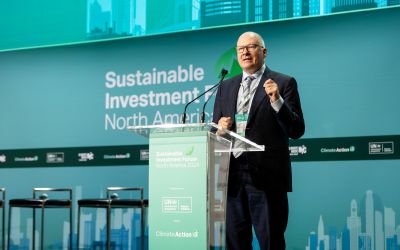Stefan Schaible on how to ensure innovations reach the necessary scale to create real impact
After COP28, Climate Action caught up with Stefan Schaible, Global Managing Partner at Roland Berger, to discuss what is needed to ensure innovations reach the necessary scale to create real impact.

After COP28, Climate Action caught up with Stefan Schaible, Global Managing Partner at Roland Berger, to discuss what is needed to ensure innovations reach the necessary scale to create real impact.
In your keynote at the Sustainable Innovation Forum (SIF) alongside COP28, you stressed the critical role of innovation in combating climate change. Can you explain why innovation is key?
By 2050, around 9.7 billion people will be living on this planet. Most of this growth will come from urban areas in Asia and Africa. These regions are still dealing with fundamental issues such as diseases, malnutrition and insufficient education. Naturally, lifting people out of poverty is their top priority. For this to happen, global GDP per capita will need to grow.
At the same time, we need to significantly reduce global energy demand and increase the share of renewable energy in the energy mix. A huge task: According to IRENA’s 1.5°C pathway, and the COP28 commitment to triple renewable power globally, renewable power generation capacity in the G20 countries alone needs to grow from under 3 TW in 2022 to 9.4 TW by 2030.
In other words, economic growth and climate action need to go hand in hand. Our only chance to deliver on both lies in technology and innovation.
Why are decarbonization technologies currently failing to realize their full potential?
Many of the essential technologies needed to decarbonize our economies still lack full-scale industrial deployment. This is mainly due to high costs, insufficient infrastructure and slow adoption rates. Consider steel production: The switchover to hydrogen-based green steel production through renewable-powered electrolysis is crucial to decarbonize the industry. Hence, green steel must become globally competitive as soon as possible. This requires not only substantial investments in electrolyzers, and renewable energy sources to power them, but also investment in a pipeline infrastructure and the ramp-up of mature offtake markets.
Another example of decarbonization solutions that are still in their infancy are carbon capture, storage and utilization technologies. These technologies are particularly essential to reduce emissions in hard-to-abate sectors such as steel, cement and chemicals. To build up the critical infrastructure, multi-billion-dollar investments from different stakeholders are required, which are lacking due to uncertainties about the respective maturity levels.
How can we ensure innovations reach the necessary scale to create real impact?
I think it would be too easy to delegate the main responsibility to governments. Certainly, the public sector plays a crucial role in building up innovation ecosystems through the right frameworks and incentives. This ranges from innovation-driven education systems to start-up co-funding and tax incentives for R&D to an attractive capital market. However, the biggest potential to reduce emissions lies in the private sector: 40 companies alone could slash more than 10 percent of global CO2 emissions given their asset ownership, as highlighted in Roland Berger’s Global Carbon Restructuring Plan.
Around the globe, competition in open and functioning markets has proven to be the most reliable tool for fostering innovation. If companies are shielded from transformative pressures by lavish subsidies, they will fail to innovate sufficiently. This not only costs us valuable time in fighting climate change – it also harms exactly those companies that governments seek to protect, as sustainable innovation presents significant business opportunities to gain competitive advantages.
How do geopolitical frictions affect global climate action?
Climate change is a global challenge that requires concerted international efforts. However, the current geopolitical insecurities are leading to a shift from globalized, interdependent value chains towards localized, decoupled ones. Since the late 2000s, the number of regional trade agreements has been declining – just recently, an EU-Australia trade agreement failed. To master the challenges of climate change, we need a ‘re-globalization’: an expansion of global value chains with a new division of labor. Because we can only properly scale innovations and make new technology affordable through globally connected value chains. This would enable economies to capitalize on their specific competitive advantages, be it raw materials, labor costs or productivity rates.
How will emerging economies benefit from this ‘re-globalization’?
A ‘re-globalization’ is a win-win situation for both developed and emerging countries. Developed economies benefit from attractive production locations and access to critical raw materials to scale their decarbonization solutions and diversify value chains. In return, emerging economies gain access to the capital needed to finance both industrialization and the clean energy transformation. The current investment gap is huge: Emerging economies need renewable energy investments of about USD 1.7 trillion each year – but only attracted about USD 544 billion in 2022. Foreign direct investment inflows from international investors will be crucial to drive decarbonization efforts. In addition, emerging economies can become major global exporters of renewable energies through their abundance of sun and wind.






